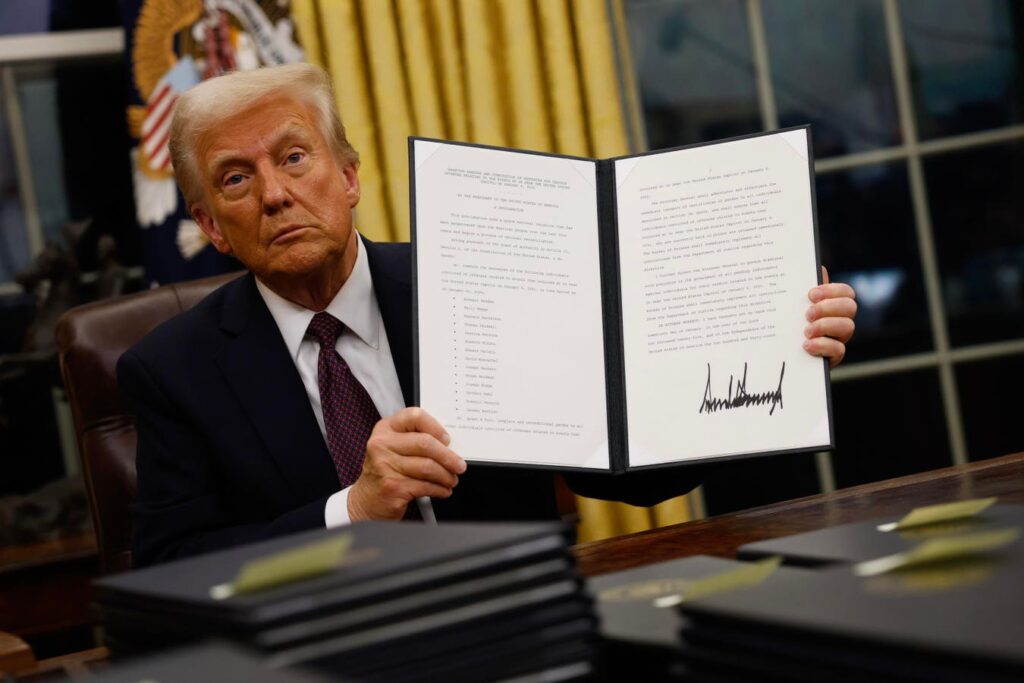WASHINGTON, DC – JANUARY 20: President Donald Trump signs executive orders in the Oval Office on … More
Getty ImagesHouse GOP Student Loan Plan Would End Most Income-Driven Repayment Plans
On Monday, Republicans on the House Education and Workforce Committee unveiled their proposed plans for higher education reform as part of the broader Republican budget reconciliation process. The 103-page bill House GOP Student Loan Plan includes student loan proposals that could reshape how Americans take on and repay college debt. “Colleges have ridden this gravy train of taxpayer dollars without any accountability for the quality of the education they provide or whether students can find jobs when they graduate,” Committee Chair Tim Walberg (R-Michigan) said in a press release. “This plan brings accountability and holds schools financially responsible for loading students up with debt. The bill also includes other reforms that will lower costs for students and families while ensuring the fiscal sustainability of targeted programs like the Pell Grant. The bottom line is that it’s time to fix this broken cycle that is costly to taxpayers and leaves students worse off than if they never went to college,” he added.
House GOP Student Loan Plan Proposes Massive Changes To Income-Driven Repayment Plans
A central component of the broader GOP education package related to student loans is to terminate most existing federal student loan repayment options and replace them with two “pared-down options,” as Politico reported. “Borrowers would have the option for a fixed monthly amount paid over a certain period of time-based on debt load or an income-based plan dubbed the ‘Repayment Assistance Plan.’”
If implemented, this would effectively repeal all existing IDR plans, including well-known options like Income-Based Repayment, Pay As You Earn, and former President Joe Biden’s SAVE plan. Estimates have pegged the savings of repealing student loan repayment plans at over $100 billion. The unveiled plan closely mirrors the proposal in the College Cost Reduction Act that Representative Virginia Foxx (R-North Carolina) has championed. The Congressional Budget Office scored that proposal as reducing spending by over $127 billion over 10 year.
While limiting the number of plans, the new repayment plan would “address the most vexing problem in the income-driven repayment system: negative amortization, when borrowers who make their payments every month nonetheless see their outstanding balances rise because they aren’t paying enough to cover interest,” notes Preston Cooper, a senior fellow at the American Enterprise Institute. Borrower’s monthly payments would be tied to their income on a slide scale, capped at 10 percent of income. If the payment is insufficient to cover interest that accrued, the government would waive unpaid interest. The plan would also provide a government subsidy to ensure a student loan borrower’s principal decreases by at least $50 each month even “if the payment is insufficient to pay down the balance by that much on its own,” Cooper notes. “This ensures that borrowers who keep up with their monthly payments never see their balances rise,” he added.
House GOP Student Loan Plan: Additional Changes Beyond Income Driven Repayment
The proposal unveiled by the House Education and Workforce Committee would also limit the amount that individuals could borrow from the federal government starting July 1, 2026. If enacted, the measure would restrict undergraduates to $50,000, graduate students to $100,000, and professional program students to $150,000 of Federal Direct Unsubsidized Stafford Loans. The proposed reform would also significantly restrict Parent and Grad Plus loans.
Additionally, the bill proposes changes to the Pell Grant program. The program would be significantly expanded to include short-term workforce training programs if enacted. However, it would also raise the bar for eligibility to the program by changing the definition of what it means to be a full-time student. Instead of the current eligibility criterion where full-time is defined as being enrolled in 12 semester hours per academic year, the proposed changes would require at least 30 hours per year to be considered full-time. Furthermore, whereas it is currently possible for students to receive a federal Pell Grant even if they are enrolled less than half-time, the bill would make those students ineligible to receive a grant.
Reactions To House GOP Student Loan Plan Proposal
“The committee’s current proposal would severely restrict college access by slashing financial aid programs, eliminating basic consumer protections, and making it harder to repay student loan debt,” Sameer Gadkaree, President & CEO of The Institute for College Access & Success, said in an e-mailed statement. “In addition to being far outside the scope of the budget reconciliation process, this misguided approach will only make it more difficult for students to enroll in college, access funding to stay enrolled and graduate, and manage loan repayments,” he added.
“Congressional Republicans undoubtedly like the plan for its fiscal savings. But slaying the demon of negative amortization could be far more consequential, Cooper of the AEI stated. ”Under current IDR plans, three-quarters of borrowers see their balances rise over time because monthly payments don’t cover interest. RAP would end this practice. Instead of simply slashing payments and asking borrowers to wait around for forgiveness, the new plan gives borrowers confidence that they can pay off their debts on their own,” he added.
“We really see this as an attack on students and working families with student loan debt,” Aissa Canchola Bañez, policy director for Student Borrower Protection Center, told The Hill in February after initial versions of changes had been released. “Many of these would cause massive spikes for families with monthly student loan payments,” she added.
Next Steps For House GOP Student Loan Plan
The whole Education and Workforce Committee will take up the House GOP Student Loan Plan on Tuesday. As part of the House’s overall efforts, the committee identified at least $330 billion in cost savings to help offset the cost of President Donald Trump’s tax package.
Read the full article here


